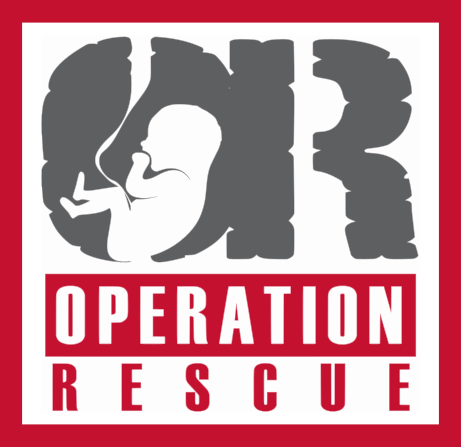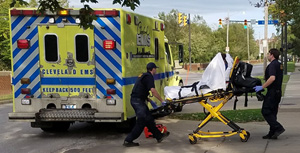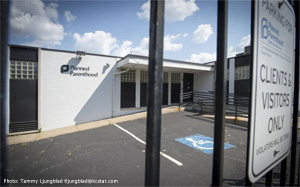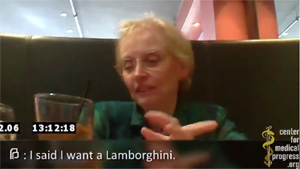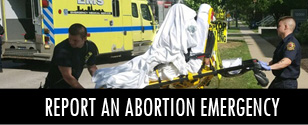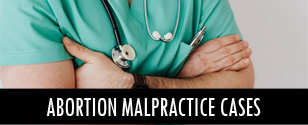By Cheryl Sullenger
Cleveland, OH – For the sixth time in 2019, an ambulance was called to Preterm, an abortion facility in Cleveland, Ohio, to transport a patient to the hospital.
According to 911 records obtained by Operation Rescue, a 24-year old patient suffered a seizure. EMS were instructed by the caller to go to the abortion facility’s back door. (See CAD printout.)
Photographs taken by pro-life activist Fred Sokol, who witnessed the incident, showed that after the woman covered in a sheet was loaded into the ambulance, EMS communicated with two people in a private vehicle, which then followed the ambulance to the hospital. The driver shielded her face to keep from being photographed.
Sokol told Operation Rescue that he saw Preterm abortionist Mitchell Reider leave the abortion facility at the end of the day. He was not in the vehicle that followed the ambulance.
This incident took place just 11 days after an ambulance transported another 24-year old woman who had hemorrhaged after an abortion to the point that she was drifting in and out of consciousness.
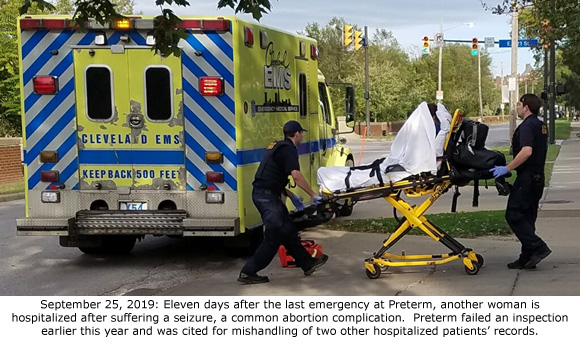
Two abortion-related deaths
On June 8, 2019, Tia Parks died one day after an abortion at Preterm, where staff neglected to detect a second pregnancy in her fallopian tube. The tube ruptured and Parks hemorrhaged internally, according to her autopsy report.
Parks was the second woman known to have died from complications to abortions received at Preterm.
On March 21, 2014, Lakisha Wilson stopped breathing after an abortion due to cardiac arrest as the result of blood loss, prompting staff to call for emergency assistance. An EMS crew was able to restart her heart, but she was later pronounced dead at a hospital.
Recently failed inspection
An inspection of Preterm was conducted by the Ohio Department of Health on May 30, 2019 — just days before Parks’ death — when the abortion facility was cited for faulty record keeping for two bleeding abortion patients who required ambulance transport to the hospital on April 5 and April 17, 2019. The 911 records for both of those emergencies was previously released by Operation Rescue.
During the April 17th incident, the inspection report noted that the abortion began at 4:31 p.m. and ended at 5:08 p.m. — a full 37 minutes later. This is an indication that the abortion was likely a late-term abortion that was done with some difficulty.
Preterm was also cited for the following:
- Failing to have a physician sign the abortion procedure record for two additional patients.
- Director of Clinic Operations admitted she was in charge of the infection control program. Yet, her personnel file showed no evidence that she had ever been trained in infection control protocols.
- Failing to post required signage in the clinic’s three waiting rooms informing women of the following: “No one can force you to have an abortion, No one–not a parent, not a husband, not a boyfriend.– No one, if someone is trying to force you to have an abortion against your will: Do not sign the consent form, If you are at an abortion facility, tell an employee of the facility that someone is trying to force you to have an abortion”.
Preterm had conducted 1,709 surgical abortions in 2019, up to the time of the May 30 inspection.
Abortion training grounds
Preterm is also an abortion training facility affiliated with the Ryan Residency Abortion Training Program through two Cleveland hospitals, Case Western Reserve University Medical Center where Preterm abortion patient Lakisha Wilson died in 2014, and the Cleveland Clinic, where Tia Parks died after an abortion at Preterm earlier this year.
The Ryan Residency Training Program is a project of the Bixby Center for Global Reproductive Health, a University of California San Francisco affiliate that works to expand abortion around the world. It is partially funded by the Susan Thompson Buffett Foundation, which is controlled by the family of Deep State billionaire Warren Buffett.
The frequent number and severity of abortion complications raise questions about the safety of the training programs at Preterm.
“Are abortion trainees are being properly supervised when conducting abortions at Preterm?” asked Operation Rescue President. “Could a lack of supervision of trainees account for the tragic abortion complications and fatal outcomes we are seeing at Preterm – just like we have seen at the RHS Planned Parenthood in Missouri?”
Newman referred to evidence that recently surfaced during a licensing dispute between the Reproductive Health Services Planned Parenthood abortion facility in St. Louis, Missouri, and the Missouri Department of Health and Senior Services (DHSS). That evidence showed that RHS Planned Parenthood’s Medical Director, Colleen McNicholas, who oversees the Ryan Residency Training Program and its Bixby Center-affiliated Fellowship in Family Planning, admitted that she is not in the procedure room when trainees conduct abortions. Several of these unsupervised trainees have been involved in horrifically botched abortions that are at the core of the DHSS’s decision not to renew its abortion license, an issue that is due to be litigated at the Administrative level at a hearing in late October.
Like Preterm, RHS Planned Parenthood also experiences a frequent number of medical emergencies that require ambulance transport of abortion patients to hospitals for care Planned Parenthood cannot provide.
“These abortion training clinics such as Preterm in Cleveland and Planned Parenthood in St. Louis pose an increased danger to women, based on our documentation and research,” said Newman. “An in-depth investigation into these abortion training programs at the Federal level is desperately needed.”
